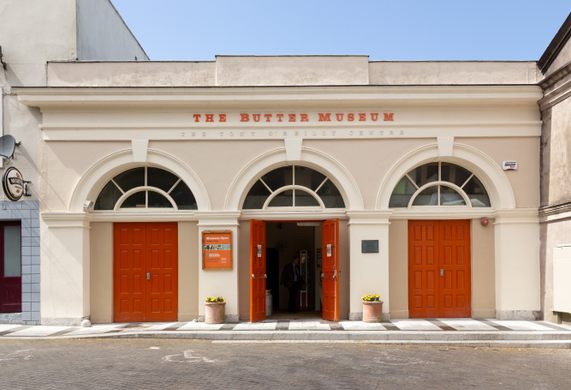The English Market
Foodie paradise with fresh meats, seafood, produce, baked goods
Foodie paradise with fresh meats, seafood, produce, baked goods
























































"A covered market dating back to the 18th century that offers a window into Ireland’s agricultural and artisanal food traditions, prized for its high-quality meats, seafood, dairy, breads, and pastries. Visitors can pick up bakery favorites from local bakers and chat with passionate vendors selling products from nearby creameries." - Stacey Leasca

"If Guinness is Ireland’s most important liquid export, butter takes the cake (the stick?) as one of its most important food exports. The Cork Butter Museum tells its story, going back as far as their prized possession — a wooden barrel of thousand year old bog butter. The Museum is in the Shandon section of Cork, the historic market center of the city. Known at the time as a “shambles,” open markets and butcheries like this one go back centuries. Cattle and dairy farming had traditionally been the most important domestic industries in Ireland, and beginning in the 1700s the export market for Irish butter began to flourish. By the mid-1800s the market in Cork had the largest butter exchange in the world, and Irish butter could be found on tables across the globe, from North America to the Caribbean to India. Housed in the former market, the Cork Butter Museum is next to the Firkin Crane Building, an unusual rotunda that was originally part of the exchange. Built in 1855, it sits on the site of the medieval Shandon Castle, and today is a public performance space. The museum also tells the story of how Kerrygold came to prominence in the international butter market in the second half of the 20th century. Tracing its roots all the way back to that thousand year old bog butter, Kerrygold (a product of the Irish Dairy Board, Ireland’s dairy cooperative) has continued the tradition of exported Irish butter. It still makes its way around the globe, sitting in just about every dairy case next to the Land-o-Lakes and I Can’t Believe It’s Not Butter." - ATLAS_OBSCURA


"If Guinness is Ireland’s most important liquid export, butter takes the cake (the stick?) as one of its most important food exports. The Cork Butter Museum tells its story, going back as far as their prized possession — a wooden barrel of thousand year old bog butter. The Museum is in the Shandon section of Cork, the historic market center of the city. Known at the time as a “shambles,” open markets and butcheries like this one go back centuries. Cattle and dairy farming had traditionally been the most important domestic industries in Ireland, and beginning in the 1700s the export market for Irish butter began to flourish. By the mid-1800s the market in Cork had the largest butter exchange in the world, and Irish butter could be found on tables across the globe, from North America to the Caribbean to India. Housed in the former market, the Cork Butter Museum is next to the Firkin Crane Building, an unusual rotunda that was originally part of the exchange. Built in 1855, it sits on the site of the medieval Shandon Castle, and today is a public performance space. The museum also tells the story of how Kerrygold came to prominence in the international butter market in the second half of the 20th century. Tracing its roots all the way back to that thousand year old bog butter, Kerrygold (a product of the Irish Dairy Board, Ireland’s dairy cooperative) has continued the tradition of exported Irish butter. It still makes its way around the globe, sitting in just about every dairy case next to the Land-o-Lakes and I Can’t Believe It’s Not Butter." - ATLAS_OBSCURA


"If Guinness is Ireland’s most important liquid export, butter takes the cake (the stick?) as one of its most important food exports. The Cork Butter Museum tells its story, going back as far as their prized possession — a wooden barrel of thousand year old bog butter. The Museum is in the Shandon section of Cork, the historic market center of the city. Known at the time as a “shambles,” open markets and butcheries like this one go back centuries. Cattle and dairy farming had traditionally been the most important domestic industries in Ireland, and beginning in the 1700s the export market for Irish butter began to flourish. By the mid-1800s the market in Cork had the largest butter exchange in the world, and Irish butter could be found on tables across the globe, from North America to the Caribbean to India. Housed in the former market, the Cork Butter Museum is next to the Firkin Crane Building, an unusual rotunda that was originally part of the exchange. Built in 1855, it sits on the site of the medieval Shandon Castle, and today is a public performance space. The museum also tells the story of how Kerrygold came to prominence in the international butter market in the second half of the 20th century. Tracing its roots all the way back to that thousand year old bog butter, Kerrygold (a product of the Irish Dairy Board, Ireland’s dairy cooperative) has continued the tradition of exported Irish butter. It still makes its way around the globe, sitting in just about every dairy case next to the Land-o-Lakes and I Can’t Believe It’s Not Butter." - ATLAS_OBSCURA


"With the beloved and ancient English Market as the town’s traditional heart." - Eater Staff